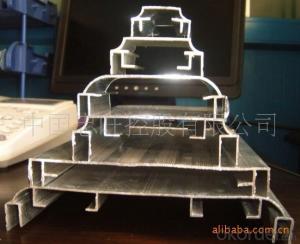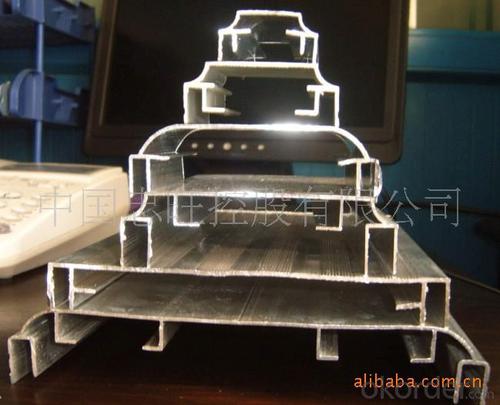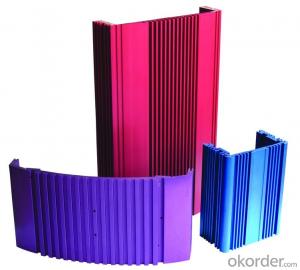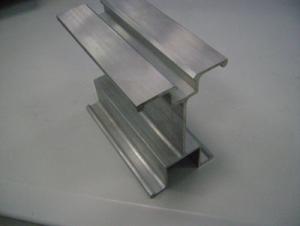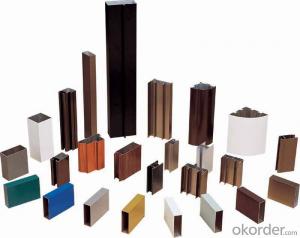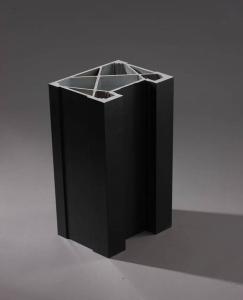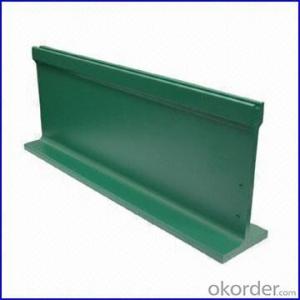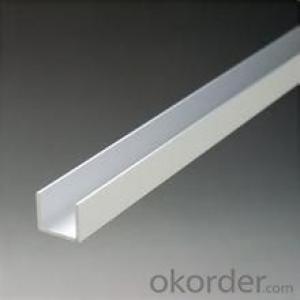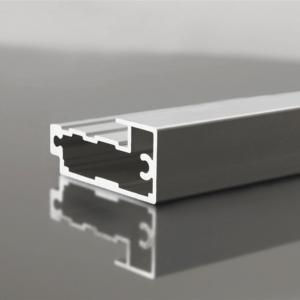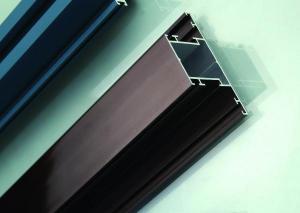LED Aluminum Extrusion Profiles Canada
OKorder Service Pledge
OKorder Financial Service
You Might Also Like
Weare the largest aluminum profile manufacture in
The detail descriptions of aluminum profile as bellowing:
Alloy Aluminum 6063,6061,6005,6082 or customer nominated | |
Temper | T3, T4, T5, T6 and other |
Surface | Anodize, electrophoresis, powder coating, PVDF coating, wood grain painting, etc. |
Colour | Any colour based on Standard Germany RAL Mark |
Length | Not more than 16 meters |
Good Package | Inner plastic film /outside carton/wooden pallets |
Payment Method | T/T, L/C, etc |
Delivery Time | Normally 2-4 weeks, Delivery time can be consulted. |
Press Machine | 500-12500 tons all together 93 press lines. |
Fabrication | 1. LED frame; 2. Drilling; 3. Bending; 4. Cutting; 5. etc. |
Certificate | ISO/TS 16949,DNV,IRIS,CCS,AFA,etc. |
Dies | 1. Using our dies, no fee; |
2. Using customer drawing, opening dies, usually about 5~50 tons then the dies cost can be refunded. | |
3. Die cost is negotiable base on the order quantity | |
Capability | Annual output 800,000 tons |
- Q: How do aluminum profiles contribute to energy-efficient lighting systems?
- Aluminum profiles play a significant role in enhancing the energy efficiency of lighting systems. Firstly, aluminum is a lightweight and highly conductive material, allowing for efficient heat dissipation. This is crucial in lighting systems as excessive heat can reduce the lifespan and efficiency of the bulbs. By using aluminum profiles, the heat generated by the light source can be effectively transferred away, ensuring optimal performance and longevity. Furthermore, aluminum profiles are versatile and can be designed to accommodate various lighting components such as LED strips or bulbs, reflectors, and lenses. These profiles provide a stable and secure housing for these components, preventing any damage or misalignment that could impact the efficiency of the lighting system. Additionally, aluminum profiles often feature precision engineering, allowing for easy installation and maintenance, further contributing to the overall energy efficiency of the system. Another key advantage of aluminum profiles is their ability to act as a heat sink. By directing heat away from the light source, the profiles help to maintain lower operating temperatures, reducing energy consumption and increasing the efficiency of the lighting system. This is particularly important for LED lighting, as they are highly sensitive to heat and can experience significant light output degradation if not properly cooled. Aluminum profiles enable efficient thermal management, ensuring that the LED lights operate at their optimum level, saving energy and reducing the need for frequent replacements. Moreover, aluminum is a recyclable material, making it an environmentally friendly choice for lighting systems. Using aluminum profiles promotes sustainable practices by reducing the demand for raw materials and minimizing waste. This aligns with the principles of energy efficiency and conservation, as it reduces the overall carbon footprint of the lighting system. In summary, aluminum profiles contribute to energy-efficient lighting systems by facilitating effective heat dissipation, providing a stable housing for lighting components, acting as a heat sink, and promoting sustainable practices. These profiles enhance the performance, lifespan, and energy efficiency of lighting systems, making them an essential component in modern lighting solutions.
- Q: Can aluminum profiles be utilized in creating distinctive architectural structures?
- <p>Yes, aluminum profiles can be used to create unique architectural designs. They are favored for their strength, lightweight, and corrosion resistance. Architects can utilize aluminum's flexibility to design complex structures, such as intricate facades, modern window systems, and innovative support frameworks. Aluminum's adaptability allows for both functional and aesthetically pleasing designs, making it a popular choice in contemporary architecture.</p>
- Q: Are aluminum profiles suitable for use in exterior insulation systems?
- <p>Yes, aluminum profiles can be used for exterior insulation systems. They offer high strength, durability, and resistance to weathering, making them ideal for external applications. Aluminum profiles are lightweight, easy to install, and can be used to create a robust framework for insulating materials, enhancing the energy efficiency and thermal performance of buildings.</p>
- Q: Can aluminum profiles be used for trade show booths?
- Indeed, trade show booths can utilize aluminum profiles. These profiles, being lightweight and durable, lend themselves well to customization, accommodating a wide range of shapes and sizes. They serve as a reliable foundation for constructing trade show booths, while also granting design flexibility, facilitating effortless assembly, disassembly, and transport. Furthermore, aluminum profiles can be seamlessly integrated with other materials like fabric, glass, or acrylic panels, creating trade show booths that are both visually captivating and practical. In summary, owing to their versatility, strength, and user-friendliness, aluminum profiles remain a favored option in the trade show industry.
- Q: Can aluminum profiles be used in the production of laboratory equipment?
- Laboratory equipment manufacturing can utilize aluminum profiles effectively. Aluminum, being a versatile material, finds application in multiple industries, including the production of laboratory equipment. Aluminum profiles provide numerous benefits in this regard. To begin with, aluminum possesses a combination of lightweight and strength, making it an ideal choice for constructing portable or frequently movable equipment within laboratories. Its lightweight nature reduces the strain on laboratory personnel while handling and transporting the equipment. Moreover, aluminum profiles offer easy shaping and molding capabilities, enabling the customization of laboratory equipment to meet specific requirements. This design flexibility allows for the creation of equipment with complex shapes and structures, ensuring optimal functionality and efficiency. In addition, aluminum exhibits excellent corrosion resistance, a crucial property in laboratory settings where exposure to chemicals and liquids is common. This corrosion resistance extends the lifespan of the equipment and maintains its good condition even after prolonged use. Furthermore, aluminum profiles can be anodized or coated to provide additional protection against wear, scratches, and other forms of damage. This enhances the durability and facilitates easier cleaning, ensuring the maintenance of required hygiene standards in laboratories. Lastly, aluminum possesses high conductivity, making it suitable for applications that require heat transfer or electrical conductivity. This property proves advantageous for laboratory equipment, such as heating plates, heat sinks, or electrical circuit components. In conclusion, aluminum profiles are indeed suitable for the production of laboratory equipment. Their lightweight, malleable, corrosion-resistant, and conductive properties make them an excellent choice for manufacturing various types of laboratory equipment, guaranteeing durability, functionality, and ease of use.
- Q: Can aluminum profiles be used in food-grade applications?
- Indeed, food-grade applications can make use of aluminum profiles. Aluminum, a lightweight and non-toxic metal, is widely utilized in the food industry due to its corrosion resistance. It is commonly employed in the fabrication of various food processing equipment, including conveyor systems, tanks, shelves, and frames. Additionally, aluminum profiles find utility in the construction of cleanrooms and other sanitary environments where food handling and storage take place. Notably, aluminum is easily sanitized and cleaned, making it an appropriate choice for food-grade applications. Nonetheless, it is crucial to ensure that the aluminum profiles employed are specifically designed for food-grade purposes and adhere to the pertinent regulations and standards. This guarantees the safety and quality of the processed or stored food.
- Q: Are there any specific cleaning and maintenance instructions for aluminum profiles?
- Yes, there are specific cleaning and maintenance instructions for aluminum profiles. Here are a few guidelines to follow: 1. Regular cleaning: Aluminum profiles should be regularly cleaned to maintain their appearance and prevent corrosion. Use a mild soap or detergent mixed with water to clean the surface. Avoid using abrasive cleaners or steel wool as they can scratch the aluminum. 2. Avoid harsh chemicals: Harsh chemicals can damage the protective coating on the aluminum profiles. Avoid using strong acids, alkaline cleaners, or solvents for cleaning purposes. 3. Rinse thoroughly: After cleaning, make sure to rinse the aluminum profiles thoroughly with clean water. This will remove any residue from the cleaning solution and prevent streaking. 4. Dry thoroughly: After rinsing, dry the aluminum profiles completely using a soft cloth or towel. Moisture left on the surface can lead to corrosion, so it's important to ensure the profiles are completely dry. 5. Lubrication: If the aluminum profiles have moving parts or hinges, it's recommended to lubricate them regularly to ensure smooth operation. Use a lubricant specifically designed for aluminum to avoid any adverse effects. 6. Protective coatings: Some aluminum profiles come with protective coatings, such as anodized or powder-coated finishes. These coatings provide an extra layer of protection against corrosion and should be maintained as per the manufacturer's instructions. 7. Avoid abrasive cleaning tools: When cleaning aluminum profiles, avoid using abrasive cleaning tools such as brushes or scouring pads. These can scratch the surface and damage the protective coating. It's important to note that specific cleaning and maintenance instructions may vary depending on the type and finish of the aluminum profiles. Therefore, it's always advisable to refer to the manufacturer's guidelines for the best cleaning and maintenance practices for your specific aluminum profiles.
- Q: Can aluminum profiles be used for transportation applications?
- Yes, aluminum profiles can be used for transportation applications. Aluminum is a lightweight and durable material, making it ideal for various transportation purposes. It is commonly used in the construction of vehicles, including cars, trucks, trains, airplanes, and ships. Aluminum profiles can be used to create strong and rigid structures, reducing the overall weight of the vehicle, which in turn improves fuel efficiency and reduces emissions. Additionally, aluminum is resistant to corrosion, making it suitable for outdoor and maritime applications. The versatility and strength of aluminum profiles make them a popular choice in the transportation industry.
- Q: Where is the aluminum profile market in Nanjing? Specific address, bus route
- Aluminum does not have the corresponding market basically, basically in Nanjing to do a relatively large Nanjing Meida aluminum, Nanjing Heng aluminium, yum Nanjing aluminum, Nanjing to build up the aluminum industry, basically is the nature of the company, you can go directly to their website to search their own needs aluminum.
- Q: Can aluminum profiles be used in the production of automotive interiors?
- Yes, aluminum profiles can be used in the production of automotive interiors. Aluminum profiles offer lightweight, durable, and corrosion-resistant properties, making them suitable for various interior components such as door panels, dashboard trims, seat frames, and console accents. Additionally, aluminum profiles can be easily customized and integrated with other materials, allowing for innovative designs and improved functionality in automotive interiors.
Send your message to us
LED Aluminum Extrusion Profiles Canada
OKorder Service Pledge
OKorder Financial Service
Similar products
Hot products
Hot Searches
Related keywords
